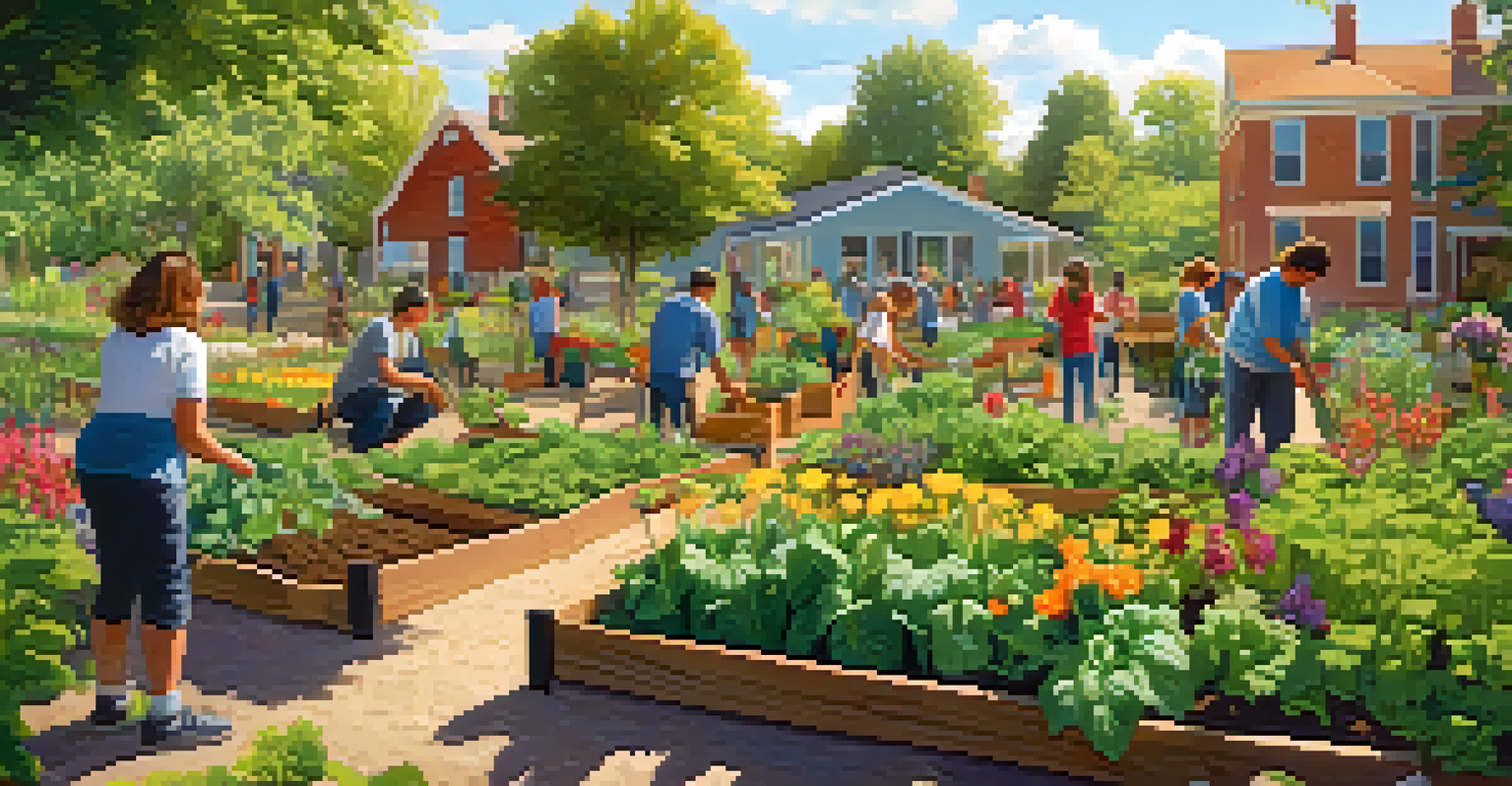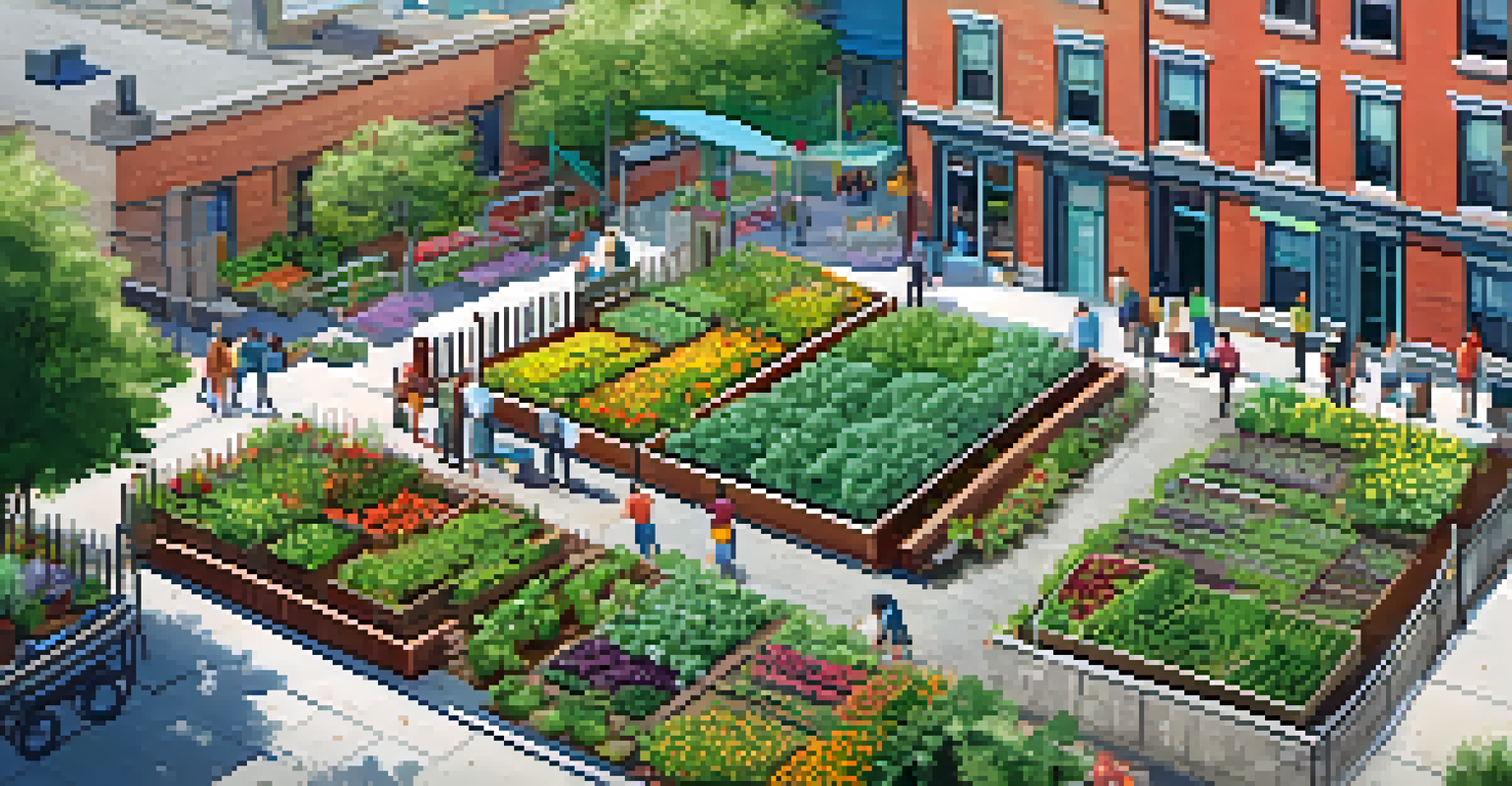Community Gardens: A Solution to Urban Food Deserts

Understanding Urban Food Deserts and Their Impact
Urban food deserts are areas where residents lack easy access to affordable and nutritious food. Often found in low-income neighborhoods, these regions can lead to poor dietary choices and health issues like obesity and diabetes. The absence of grocery stores or fresh produce markets creates a reliance on convenience stores, which typically offer processed foods.
Access to healthy food is a fundamental right, not a privilege.
These food deserts not only affect individual health but also contribute to broader community challenges. Without access to fresh fruits and vegetables, families struggle to maintain balanced diets. Over time, such conditions can lead to significant public health crises, placing additional strain on healthcare systems.
By understanding the dynamics of food deserts, we can begin to appreciate the role community gardens play in transforming these landscapes. They provide residents with direct access to fresh produce, while also fostering a sense of community and collaboration among neighbors.
The Role of Community Gardens in Urban Areas
Community gardens are shared spaces where individuals come together to grow fruits and vegetables, often in vacant lots or underutilized areas. These gardens not only provide food but also create a vibrant community hub where people can connect and cultivate relationships. They can be a source of pride, creativity, and learning for residents of all ages.

In addition to food production, community gardens promote environmental sustainability. They contribute to urban biodiversity by attracting pollinators and other wildlife, while also improving air quality and reducing urban heat. The green spaces provide much-needed relief from concrete jungles, offering a natural setting for relaxation and socialization.
Urban Food Deserts Impact Health
Lack of access to nutritious food in urban food deserts leads to poor dietary choices and health issues like obesity and diabetes.
Moreover, community gardens often serve educational purposes, teaching gardening skills and healthy eating habits. Workshops and events can empower residents with knowledge about nutrition and sustainable practices, further enhancing the community's resilience and well-being.
Building Community Through Shared Gardening Experiences
One of the most beautiful aspects of community gardens is their ability to bring people together. Neighbors who may not have interacted otherwise find common ground in their shared gardening efforts. This collaboration fosters friendships, encourages teamwork, and creates a supportive network.
Gardening is a way of showing that you believe in tomorrow.
In many community gardens, members share responsibilities, from planting and watering to harvesting and maintaining the space. This shared labor not only strengthens bonds but also cultivates a sense of ownership and pride in the garden's success. When people see the fruits of their labor, both literally and figuratively, it boosts morale and investment in their community.
Additionally, community gardens often host events that celebrate diversity and culture, such as potlucks or harvest festivals. These gatherings create opportunities for people to share their culinary traditions, learn from one another, and embrace the rich tapestry of backgrounds within the neighborhood.
Community Gardens as Educational Platforms
Community gardens offer a unique platform for education, particularly around nutrition and sustainable agriculture. Schools and local organizations often partner with gardens to provide hands-on learning experiences for children and adults alike. Participants can learn not just about growing food, but also about the importance of biodiversity and ecological practices.
These educational initiatives help demystify the food production process, empowering individuals to make healthier choices. When people learn where their food comes from and how to grow it themselves, they are more likely to incorporate fresh produce into their diets. This knowledge can have a profound impact on community health and well-being.
Community Gardens Foster Connections
Shared gardening experiences in community gardens create bonds among neighbors and promote a sense of ownership and pride.
Moreover, community gardens frequently host workshops on cooking and nutrition, encouraging participants to use their homegrown produce in delicious ways. These classes can introduce new recipes and cooking techniques, further enhancing the garden's role as a center for learning and community engagement.
The Environmental Benefits of Community Gardens
Community gardens also play a crucial role in promoting environmental sustainability in urban areas. By converting vacant lots into green spaces, they help to absorb rainwater, reduce runoff, and mitigate flooding. This is especially important in cities where concrete and asphalt dominate the landscape.
Moreover, gardens contribute to urban biodiversity by providing habitats for pollinators and other wildlife. They can foster ecosystems that support various plants and animals, which in turn creates a more resilient urban environment. This biodiversity is vital for maintaining ecological balance and enhancing overall community health.
Additionally, community gardens encourage sustainable practices such as composting and organic gardening. These practices not only reduce waste but also enrich the soil, leading to healthier plants and a more productive garden. As residents learn and adopt these practices, they contribute to a greener, more sustainable future.
Challenges Faced by Community Gardens
While community gardens offer numerous benefits, they also face challenges that can hinder their success. Limited funding and resources can make it difficult for gardens to maintain their operations and expand their reach. Many gardens rely on grants, donations, and volunteer labor to sustain them, which can be unpredictable.
Additionally, community gardens often grapple with issues of land tenure and security. As urban development pressures increase, gardens may be threatened by construction or changes in zoning laws. This uncertainty can create anxiety among gardeners who invest time and effort into their plots, knowing they might lose access to the land.
Education Through Gardening Initiatives
Community gardens serve as educational platforms where individuals learn about nutrition, sustainable practices, and food production.
Lastly, ensuring inclusivity and participation from all community members can be a challenge. Some individuals may feel intimidated or hesitant to join gardening efforts due to a lack of experience or cultural barriers. Overcoming these hurdles requires intentional outreach and programming that welcomes everyone to participate in the gardening community.
How to Start a Community Garden in Your Neighborhood
Starting a community garden can be a rewarding endeavor for neighborhoods looking to combat food deserts. The first step is to gather interested individuals who share a passion for gardening and community improvement. Forming a planning committee can help to outline goals, identify potential locations, and secure resources.
Once a location is established, it's essential to engage with local authorities and the community to gain support. This might involve obtaining permits, forming partnerships with local organizations, or seeking funding through grants or donations. Building relationships with stakeholders can greatly enhance the garden's chances of long-term success.

Finally, once the garden is up and running, fostering a collaborative and inclusive environment is key. Regular meetings, workshops, and social events can help to maintain enthusiasm and encourage participation. By nurturing a sense of community, the garden can thrive and become a valuable resource for all residents.